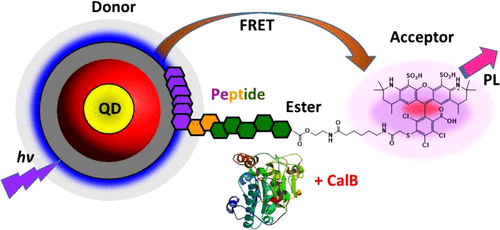Our official English website, www.x-mol.net, welcomes your
feedback! (Note: you will need to create a separate account there.)
Quantum Dot Lipase Biosensor Utilizing a Custom-Synthesized Peptidyl-Ester Substrate.
ACS Sensors ( IF 8.2 ) Pub Date : 2020-02-25 , DOI: 10.1021/acssensors.9b02291 Joyce C Breger 1 , Kimihiro Susumu 2, 3 , Guillermo Lasarte-Aragonés 1, 4 , Sebastián A Díaz 1 , Jesper Brask 5 , Igor L Medintz 1
ACS Sensors ( IF 8.2 ) Pub Date : 2020-02-25 , DOI: 10.1021/acssensors.9b02291 Joyce C Breger 1 , Kimihiro Susumu 2, 3 , Guillermo Lasarte-Aragonés 1, 4 , Sebastián A Díaz 1 , Jesper Brask 5 , Igor L Medintz 1
Affiliation

|
Lipases are an important class of lipid hydrolyzing enzymes that play significant roles in many aspects of cell biology and digestion; they also have large roles in commercial food and biofuel preparation and are being targeted for pharmaceutical development. Given these, and many other biotechnological roles, sensitive and specific biosensors capable of monitoring lipase activity in a quantitative manner are critical. Here, we describe a Förster resonance energy transfer (FRET)-based biosensor that originates from a custom-synthesized ester substrate displaying a peptide at one end and a dye acceptor at the other. These substrates were ratiometrically self-assembled to luminescent semiconductor quantum dot (QD) donors by metal affinity coordination using the appended peptide's terminal hexahistidine motif to give rise to the full biosensing construct. This resulted in a high rate of FRET between the QD donor and the proximal substrate's dye acceptor. The lipase hydrolyzed the intervening target ester bond in the peptide substrate which, in turn, displaced the dye acceptor containing component and altered the rate of FRET in a concentration-dependent manner. Specifics of the substrate's stepwise synthesis are described along with the sensors assembly, characterization, and application in a quantitative proof-of-concept demonstration assay that is based on an integrated Michaelis-Menten kinetic approach. The utility of this unique nanoparticle-based architecture within a sensor configuration is then discussed.
中文翻译:

利用定制合成的肽基-酯底物的量子点脂肪酶生物传感器。
脂肪酶是一类重要的脂质水解酶,在细胞生物学和消化的许多方面起着重要作用。它们在商业食品和生物燃料的制备中也起着重要作用,并且正成为药物开发的目标。考虑到这些以及许多其他生物技术的作用,能够定量监测脂肪酶活性的灵敏且特定的生物传感器至关重要。在这里,我们描述了一种基于Förster共振能量转移(FRET)的生物传感器,该传感器起源于定制合成的酯底物,该底物在一端显示肽,而在另一端显示染料受体。通过使用附加的肽'通过金属亲和力配比,将这些底物按比例自组装为发光半导体量子点(QD)供体。S末端的六组氨酸基序产生完整的生物传感构建体。这导致QD供体和近端基质的染料受体之间的FRET率很高。脂肪酶水解了肽底物中的中间目标酯键,进而取代了含染料受体的组分,并以浓度依赖的方式改变了FRET的速率。描述了基质逐步合成的细节,以及传感器的组装,表征和在基于集成Michaelis-Menten动力学方法的定量概念验证演示测定中的应用。然后讨论了这种独特的基于纳米粒子的架构在传感器配置中的实用性。的染料受体。脂肪酶水解了肽底物中的中间目标酯键,进而取代了含染料受体的组分,并以浓度依赖的方式改变了FRET的速率。描述了基质逐步合成的细节,以及传感器的组装,表征和在基于集成Michaelis-Menten动力学方法的定量概念验证演示测定中的应用。然后讨论了这种独特的基于纳米粒子的架构在传感器配置中的实用性。的染料受体。脂肪酶水解了肽底物中的中间目标酯键,进而取代了含染料受体的组分,并以浓度依赖的方式改变了FRET的速率。描述了基质逐步合成的细节,以及传感器的组装,表征和在基于集成Michaelis-Menten动力学方法的定量概念验证演示测定中的应用。然后讨论了这种独特的基于纳米粒子的架构在传感器配置中的实用性。本文描述了S的逐步合成,以及传感器的组装,表征和在基于集成Michaelis-Menten动力学方法的定量概念验证演示测定中的应用。然后讨论了这种独特的基于纳米粒子的架构在传感器配置中的实用性。本文描述了S的逐步合成,以及传感器的组装,表征和在基于集成Michaelis-Menten动力学方法的定量概念验证演示测定中的应用。然后讨论了这种独特的基于纳米粒子的架构在传感器配置中的实用性。
更新日期:2020-02-25
中文翻译:

利用定制合成的肽基-酯底物的量子点脂肪酶生物传感器。
脂肪酶是一类重要的脂质水解酶,在细胞生物学和消化的许多方面起着重要作用。它们在商业食品和生物燃料的制备中也起着重要作用,并且正成为药物开发的目标。考虑到这些以及许多其他生物技术的作用,能够定量监测脂肪酶活性的灵敏且特定的生物传感器至关重要。在这里,我们描述了一种基于Förster共振能量转移(FRET)的生物传感器,该传感器起源于定制合成的酯底物,该底物在一端显示肽,而在另一端显示染料受体。通过使用附加的肽'通过金属亲和力配比,将这些底物按比例自组装为发光半导体量子点(QD)供体。S末端的六组氨酸基序产生完整的生物传感构建体。这导致QD供体和近端基质的染料受体之间的FRET率很高。脂肪酶水解了肽底物中的中间目标酯键,进而取代了含染料受体的组分,并以浓度依赖的方式改变了FRET的速率。描述了基质逐步合成的细节,以及传感器的组装,表征和在基于集成Michaelis-Menten动力学方法的定量概念验证演示测定中的应用。然后讨论了这种独特的基于纳米粒子的架构在传感器配置中的实用性。的染料受体。脂肪酶水解了肽底物中的中间目标酯键,进而取代了含染料受体的组分,并以浓度依赖的方式改变了FRET的速率。描述了基质逐步合成的细节,以及传感器的组装,表征和在基于集成Michaelis-Menten动力学方法的定量概念验证演示测定中的应用。然后讨论了这种独特的基于纳米粒子的架构在传感器配置中的实用性。的染料受体。脂肪酶水解了肽底物中的中间目标酯键,进而取代了含染料受体的组分,并以浓度依赖的方式改变了FRET的速率。描述了基质逐步合成的细节,以及传感器的组装,表征和在基于集成Michaelis-Menten动力学方法的定量概念验证演示测定中的应用。然后讨论了这种独特的基于纳米粒子的架构在传感器配置中的实用性。本文描述了S的逐步合成,以及传感器的组装,表征和在基于集成Michaelis-Menten动力学方法的定量概念验证演示测定中的应用。然后讨论了这种独特的基于纳米粒子的架构在传感器配置中的实用性。本文描述了S的逐步合成,以及传感器的组装,表征和在基于集成Michaelis-Menten动力学方法的定量概念验证演示测定中的应用。然后讨论了这种独特的基于纳米粒子的架构在传感器配置中的实用性。











































 京公网安备 11010802027423号
京公网安备 11010802027423号